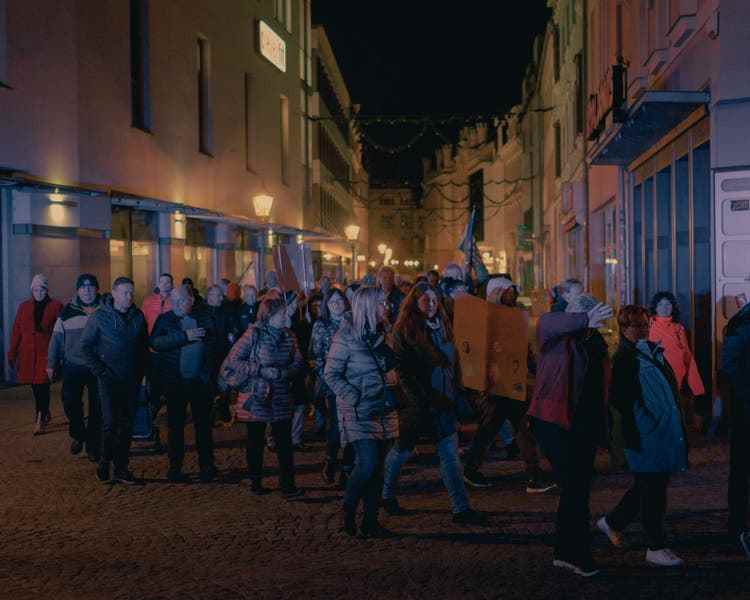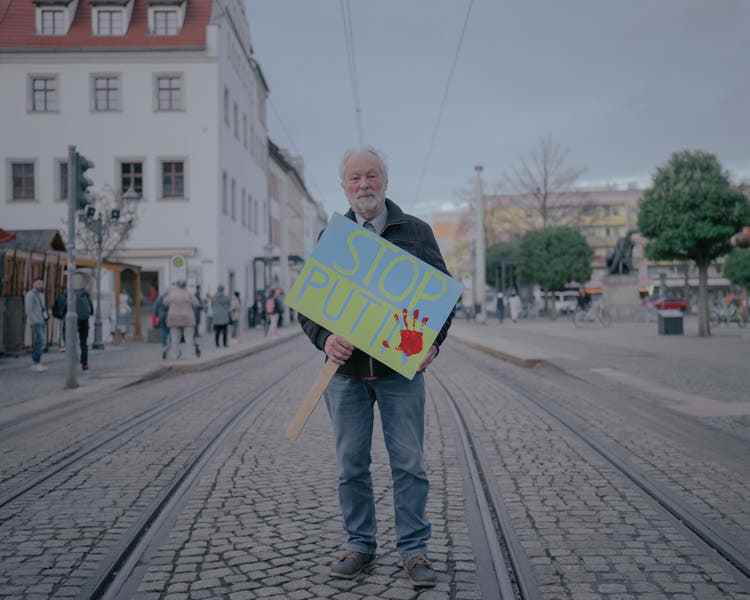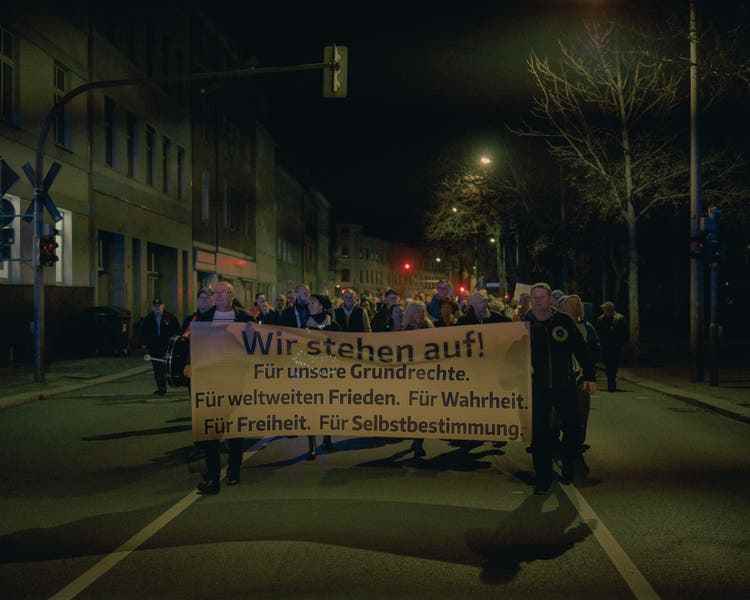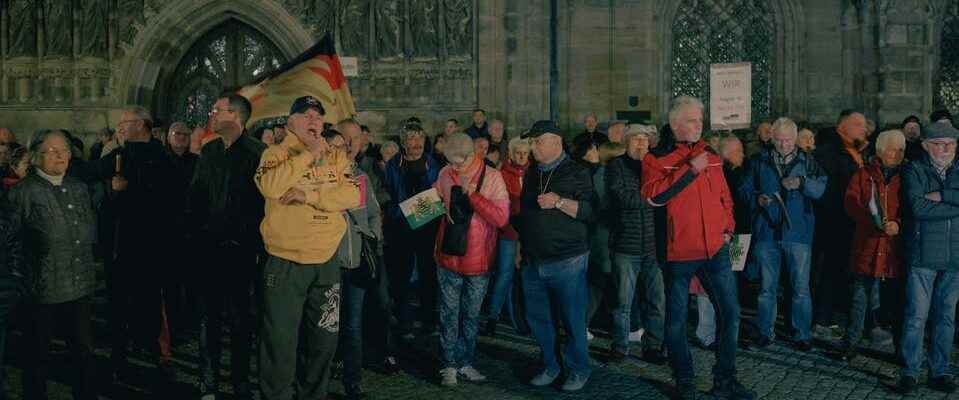Rising energy prices and high inflation drive thousands of people onto the streets in East Germany every Monday. Right-wing extremists and lateral thinkers create a mood against a “GDR 2.0”. Former GDR oppositionists are fighting back – with words and at counter-demonstrations.
Anyone who took to the streets in the GDR risked a lot – if not everything. Today there are again demonstrations on the market squares from Schwerin to Plauen, against a “new GDR” and a “dictatorship”. It’s the same slogans as in 1989 that are emblazoned on self-made posters. “We are the people,” proclaim the new Monday demonstrators for themselves. But this time it’s not about putting an end to an unjust state. Under the protection of freedom of assembly and expression, they present themselves as the legitimate heirs of the peaceful revolution. What a mockery for everyone who was there in 1989.
The fact that today’s demonstrators use the term peaceful demonstration for themselves “is an outrage and an abuse,” says Rainer Eppelmann, a former civil rights activist and current chairman of the Federal Foundation for the Reappraisal of the SED Dictatorship. “I’m surprised anyway when the Germans talk about ‘Wende’,” says Eppelmann, who was pastor of the Samaritan community in East Berlin for many years. “In 1989 there was a popular movement, a peaceful revolution and a dictatorship at that.” Egon Krenz, the last GDR head of state, publicly used the word “turn” for the first time. For this reason alone it is not the vocabulary of civil rights activists.
“We only had one candle in our hands at the time,” is how the 79-year-old Eppelmann recalls the vigils in early autumn 1989 in front of Berlin’s Gethsemane Church. At a distance of one meter, the state power was standing with the Kalashnikov at the ready. “But we didn’t let ourselves be provoked.”
With candles and whistles for the system crash
Now it is again the own compatriots from Rügen to the Ore Mountains who imagine themselves in a “new GDR” – with a strange mixture of glorification and historical falsification. In Zwickau, Saxony, there are also weekly mobilizations on Mondays – against the new “red-green dictatorship”, for the resignation of the Bundestag and Germany’s exit from the EU. Some green and white flags of the former Kingdom of Saxony, a symbol of the right-wing extremist micro-party “Free Saxony”, wave over the several hundred people on the cathedral square.
A group of younger women hold up candles, battery operated. Other participants have put on chains of lights. «We are peaceful. No alcohol, no drugs, no dogs. Only guide dogs are allowed,” one of the organizers calls into the megaphone. A cardboard dove of peace swings over the participants, others demand: “Create peace without weapons.” The cathedral bells are ringing in the background. The scenery is bizarre.
With whistles and pot lids, the demonstrators start moving loudly. It goes past the restored birthplace of the composer Robert Schumann and the imposing town hall, from which Martin Luther is said to have preached in 1522. The police kept their way through downtown Zwickau free.

Hundreds of demonstrators march through downtown Zwickau on Mondays every week.
Former civil rights activist stands in the way of lateral thinkers
Martin Böttger knows the Monday marches in Zwickau, he hasn’t gotten used to them. The misuse of the symbolism of 1989 is particularly bitter for him. “I have nothing but contempt for it,” he says. The 75-year-old is one of the co-founders of the New Forum in his hometown, was a member of the state parliament for the Greens and Stasi representative in Saxony. As an individual, you can also stand in the way of the protesters and their rhetoric, believes the former civil rights activist.
And he does that almost every week – with a self-painted sign against the Russian war of aggression. “Once someone spat in front of me,” says Böttger. But he has never been physically attacked. He is also not an anxious person, he says with a smile. That was the case in 1975, when he showed up with a poster for human rights at a May Day demonstration in the GDR, and it’s still the case today. But Böttger is not only concerned with regaining authority over the interpretation of the end of the GDR. He wants to counter lateral thinkers and radical right-wing parties.
“We don’t leave the streets to these people,” agrees Gesine Oltmanns, who also comes from the church peace movement. “For an open country with free people,” read the poster that the Oltmanns held up on September 4, 1989 in the courtyard of Leipzig’s Nikolaikirche. At that time she was 24 years old. The action was the prelude to the large Leipzig Monday demonstrations, the beginning of the end of the GDR.
This Monday, demonstrators wanted to march through Leipzig with torches – of all days, in the week of the November pogroms and the fall of the Wall. But a broad alliance of people from Leipzig was able to stop them with a blockade. That makes you optimistic for the future, says Oltmanns.

The former civil rights activist Martin Böttger stands in the way of the lateral thinkers and “Russia understanders” in Zwickau.
In East Germany there is a different protest culture
“The peculiarity of the protest culture in East Germany is fed by the experience of 1989, when street protests brought a regime to its knees,” says political scientist Alexander Leistner from the University of Leipzig. This gave rise to an expectation that this would also be possible now. The same groups and milieus as in the Corona protests were among the initiators of today’s Monday demonstrations. These would suggest that they would manage to get tens of thousands onto the streets, which is not the case. “At the same time, they use the reference to the peaceful revolution and thus play down their intentions for a political overthrow,” says the protest researcher.
Leistner also refers to the diverse crisis experiences of people in East Germany. The reunification was followed by a long, difficult transformation process until around the turn of the millennium. Then came the financial crisis, which also left a deep rift because many East Germans had only just stabilized their economic situation. “The fear that everything could disappear again overnight is more pronounced in the East,” says Leistner.
Eppelmann: “I want to be at least 93 years old”
Fears, worries about the future and helplessness also mingle on the cathedral square in Zwickau. Two women who regularly come to the Monday demonstrations want to demonstrate above all for their children and grandchildren. They report on price increases that they can no longer cope with, on retirees who have worked for more than 40 years but can no longer afford anything. “Where is this going?” they ask.
The women work for a supplier for VW Sachsen, the largest employer in the region. In the GDR they already worked in the Sachsenring works, where the Trabant was built. “If Volkswagen leaves the region, it will be pitch black here,” says one of them. She is afraid that companies will migrate to China. “The VW boss was there on the Chancellor’s trip to China. Does he think we’re stupid and don’t get the intentions?” she gets excited. Nod from her colleague.
When Eppelmann speaks to schoolchildren and young people at his many events today and reveals his greatest wish, he gets disbelieving faces. “I want to be at least 93 years old,” he says. “Because then I live a year longer in a democracy than in a dictatorship. I was 46 years old when the GDR ceased to exist.” This creates reflection, perhaps also brooding, among the young people. But this is how Eppelmann shows that history must not be forgotten or misused. It’s his personal message.

